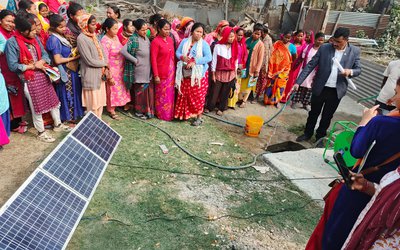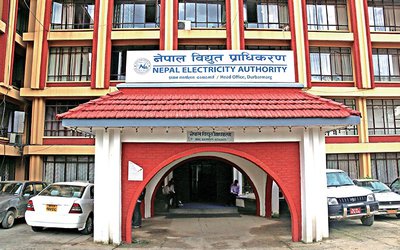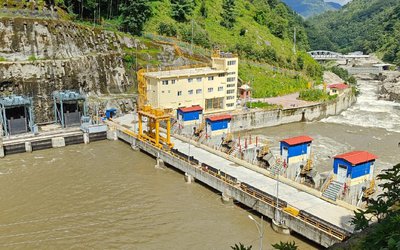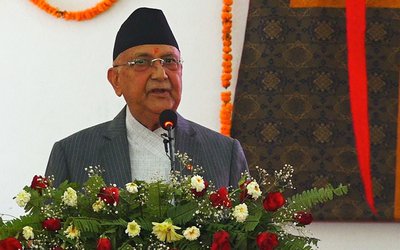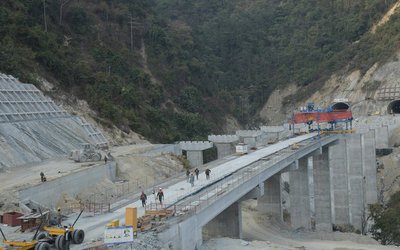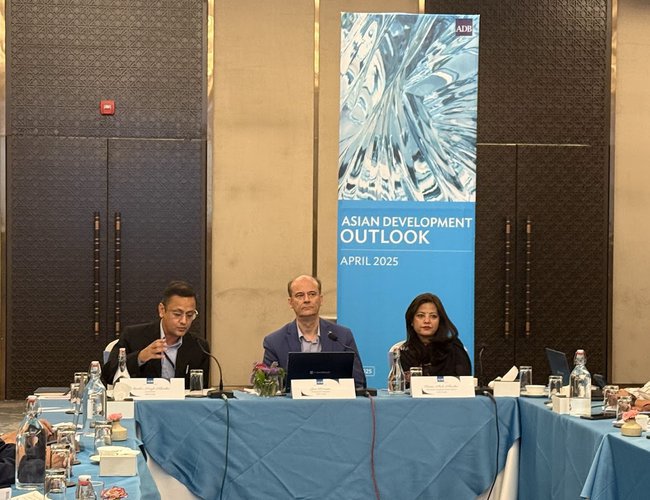
Nepal's economy is projected to strengthen in fiscal year 2025 and further improve in 2026, as per the Asian Development Outlook (ADO) April 2025 report by the Asian Development Bank (ADB). The report forecasts a 4.4% growth in Nepal's economy for FY2025, up from the estimated 3.9% growth in FY2024.
The enhanced growth outlook for Nepal is attributed to the gradual recovery of domestic demand, ongoing reforms in the private sector, and a boost in tourism and related services. Sectors like manufacturing and construction, which contracted in FY2024, are expected to expand in the current fiscal year.
This growth is supported by stable oil and raw material prices, increased liquidity, and declining interest rates, leading to improved credit availability for all production sectors. ADB Country Director for Nepal, Arnaud Cauchois, highlighted these positive developments in the country's economic outlook.
During the program, Jan Hansen, Principal Economist at ADB Resident Mission Kathmandu, emphasized the key issues outlined in the outlook and reiterated ADB's commitment to supporting Nepal's policies to address climate change.
Hansen also stated that the future global economic growth will be greatly affected by the tariff policies of the US.
Likewise, Manbir Khadka, an economist at ADB Resident Mission in Kathmandu, outlined the key points of the Nepal Economic Outlook. He pointed out that economic growth picked up speed in FY2024 and is expected to continue to climb this fiscal year and the next, mainly driven by the services sector. Khadka also pointed out that the industry growth, boosted by increased electricity production, is expected to further rise with the upcoming hydroelectric projects.

Khadka stressed that the geopolitical tensions in the Middle East and Gulf regions will have a significant impact on Nepal's economy. He underscored the region's vital role in terms of remittances for Nepal.
The forecast for gross domestic product (GDP) growth in FY2026 is 5.1%, driven by government reforms to enhance capital budget execution, improvements in tourism and related services, and increased agricultural productivity through mechanization and better irrigation systems, dependent on a favorable monsoon. Inflation is predicted to decrease in FY2025 and FY2026, staying within the central bank's limits, assuming a normal harvest and a slight decrease in inflation in India, a major source of imports.
Nepal's external sector stabilized in FY2024 with higher foreign exchange reserves and a cautious monetary policy. Despite increased imports in the latter part of FY2025, robust remittance inflows are expected to maintain a current account surplus of 0.1% of GDP. In FY2026, a deficit equivalent to 2.4% of GDP is anticipated as imports of goods and services rise.
There are downside risks to the outlook. Continued tariff increases could lead to a global economic downturn, impacting Nepal's tourism revenue and remittances, while reduced foreign aid could hinder growth as Nepal relies on it to fund development projects. Failure to fully implement the capital budget could also dampen growth prospects.
The Asian Development Bank (ADB) has forecasted that economies in developing Asia and the Pacific will grow by 4.9% this year, slightly lower than the 5.0% growth seen last year. This growth is supported by s
olid domestic demand and a strong global demand for semiconductors due to the artificial intelligence boom. However, the outlook is clouded by tariffs and trade uncertainty, which will pose challenges. The ADO April 2025 report, released today, predicts a further decline in regional growth to 4.7% next year. Inflation is expected to ease to 2.3% this year and 2.2% next year, driven by decreasing global food and energy prices. The growth forecasts were completed before the US administration's announcement of new tariffs on 2 April, so the projections only account for existing tariffs. Nonetheless, the
ADO April 2025 report includes an analysis of how higher tariffs could impact growth in Asia and the Pacific.
The report highlights that the economies in the region are strong, but there are risks due to potential rapid and significant changes in US trade and economic policies. The imposition of higher US tariffs, increased policy uncertainty, and retaliatory measures could have a negative impact on trade, investment, and growth.
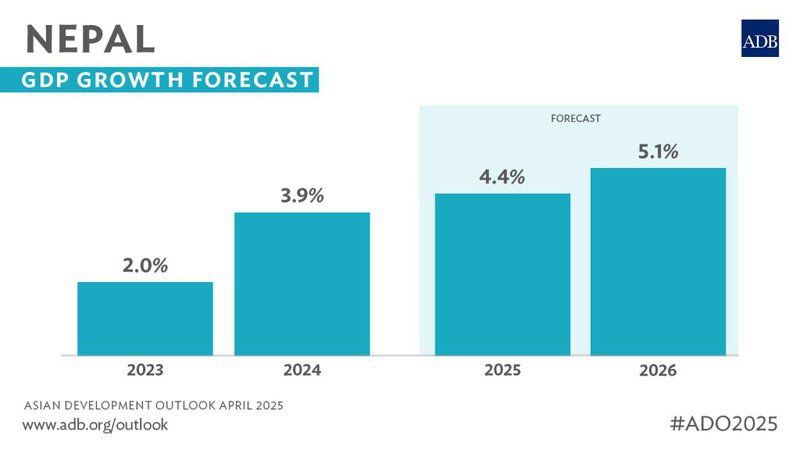
ADB Chief Economist Albert Park stated, “Developing Asia and the Pacific have solid fundamentals that are supporting their resilience in the face of global challenges. However, the rising tariffs, uncertainties surrounding US policies, and the potential for heightened geopolitical tensions are major concerns for the economic outlook. It is important for Asian economies to continue their commitment to open trade and investment, which have been key drivers of growth and resilience in the region.”
Additionally, a decline in the property market in the People’s Republic of China (PRC), the region’s largest economy, could also hinder growth. ADB forecasts a 4.7% expansion for the PRC this year and 4.3% next year, down from 5.0% last year.
Stronger economic growth in South Asia and Southeast Asia, driven by domestic demand, along with a continued recovery in tourism in other parts of the region, will help offset the slowdown in China. India, the largest economy in South Asia, is expected to grow by 6.7% this year and 6.8% next year. Economies in Southeast Asia are projected to grow by 4.7% this year and next year.
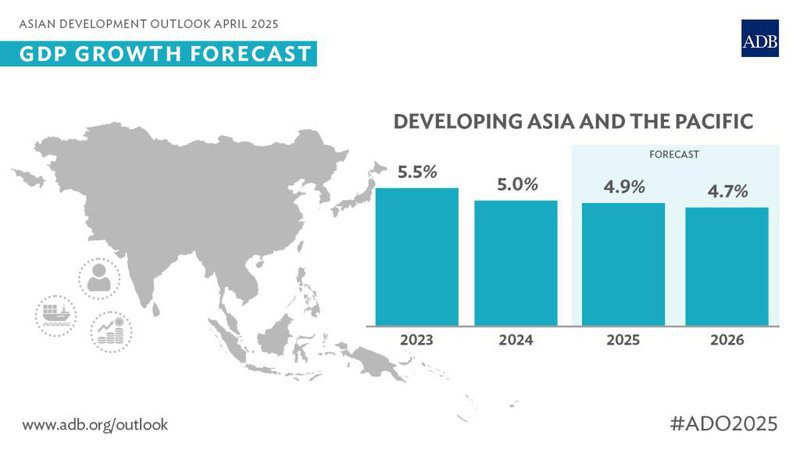
Weak external demand is likely to dampen economic activity in Caucasus and Central Asia, with growth expected to decrease from 5.7% last year to 5.4% this year and 5.0% next year. In the Pacific region, growth will be supported by tourism but at a slower rate, with forecasts of 3.9% this year and 3.6% next year, compared to 4.2% last year.
- MONETARY POLICY: Disappointing Outcome
- Jul 17, 2025
- MELAMCHI WATER SUPPLY: No Interruption During Monsoon
- Jun 25, 2025
- KOREAN RETURNEES: Successful Integration
- Jun 25, 2025
- UPPER TRISHULI-1: Engaging With Local
- Jun 25, 2025
- IME GROUP: Twenty Five Years Of Journey
- Jun 24, 2025


